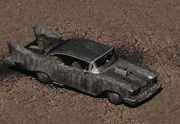Technology in the world of Fallout is different from ours. First, due to the Divergence, it has developed in a radically different direction. It's a world in which integrated circuits were developed very late and even then their popularity was limited, as people preferred the more resistant and reliable vacuum tubes. Second, the technology has progressed beyond our current level, as the development proceeded all the way until 2077 and even further in certain cases (such as the Enclave).
Much of the Fallout world and technology is inspired by 1950s pulp science fiction. The world is not our own, functioning due to a different set of rules. It is a world in which radiation can mutate people into ghouls and portable directed energy weapons are not only viable but also (relatively) widespread. This article aims to highlight the differences between the Fallout world's technology and our own.
Energy

Fusion adds the power to the armor
One of the key elements of the backstory are the Resource Wars, fought for the last remaining energy resources on Earth. In the wake of the crisis, as the economy ground to a halt, the United States sought alternatives to fossil fuel energy, arriving at two solutions - utilizing fission and fusion as the primary power sources. The first crude fusion cell was unveiled in 2066,[1] providing the United States with an edge and averting its imminent bankruptcy.
By 2077, microfusion cells were commonplace, used widely as chargers for energy-consuming technology, ranging from laser rifles to cars. However, perhaps the most representative element of the new energy source is the iconic T-51b power armor, powered by a back-mounted TX-23 Micro Fusion pack, with enough fuel capacity to allow operation for nearly a century.
Fission power sources have found their use as well, as power sources for robots,[2] which can utilize a nuclear power unit as its energy source or backup generators (typically Wattz Electrobox units, like the one used in Broken Hills).
Vehicles

Nothing can stop a Highwayman
In 2077, due to the oil crisis, gasoline was no longer a viable car fuel, even more so with the excellent power the automobiles had. As such, many car companies have desperately pursued research into alternative power sources, with Chryslus Motors finally patenting the successor to gasoline: electric engines, powered by energy cells.[3] Charged with fusion cells, a Chryslus Corvega or Highwayman featured 800+ horsepower and acceleration from 0 to 60 MPH in under a second, all done with a full analog system and no computers.[4] However, not many of these cars were produced and those that were had a limited success due to their hefty price tag ($199,999.99 for a Corvega).[5]
Steam-powered trucks were also being used by the time of the Great War,[6] and unlike the bulky nuclear cars, were also very viable for transit in the post-Apocalypse. The Master and his Unity made significant use of the trucks in such dastardly deeds as attacking Necropolis or Vault 13.
Personal protection
One of the most noticeable technological leaps was made in the field of protecting people from harm (as well as causing it, but more on that later). The United States was especially proficient at doing so, as its research into polymers paid off, resulting in suits of advanced combat armor being widely deployed across the country to police and military forces, sometimes even civilians with a special BADTFL permit.[7] This armor protected the wearer considerably from conventional and explosive damage as well as laser and plasma, a trait quite useful on the modern battlefield.
Another example of considerable advancement is the power armor, an armored suit with a hydraulic endoskeleton, powered by a fusion pack, designed to be a one-man tank replacing traditional, inefficient vehicles in their role.[8] It is an exclusively American technology, which is also the root of many other technologies, such as the aforementioned cold fusion.
Even the Great War failed to stall research into the technology, as the Enclave continued to develop new suits to create an even more powerful suit than the pre-War cutting edge T-51b power armor.
An interesting example of research into personal protection exists, in the form of the Tesla armor, a suit based on Nikola Tesla's blueprints, in which Tesla Attraction Coils attract and disperse energy attacks, providing a surprisingly effective protective apparel and another example of how Fallout's physics are different than our own.
Robotics
A fledgling field of science in our world has become a thriving industry of its own in the Fallout world. Robots are widely used and have reached a very high level of refinement and advancement. They can operate individually, can process visual and audio data in real time and make tactical decisions in the heat of the moment, operate human or inbuilt weapons with deadly accuracy and even host artificial intelligences.[9]
An indication of just how advanced robotics were is the fact, that robots were commercially available to civilians and companies, apart from the military - Mister Handy and protectron robots being the best examples of just how widespread and popular they were.
Weapons
Likely the single field in which the greatest advancements were made, weaponry of the Fallout world is varied and incredibly advanced in some regards. Apart from conventional weapons based on combustion of gunpowder, energy weapons development advanced at a rapid pace, allowing for the creation of mass produced laser, plasma and pulse rifles.
While many conventional weapons echo those available in our world (such as the AK-112 Assault Rifle or Colt Rangemaster hunting rifle), advances in high-tech, light-weight polymer have also enabled man to carry huge weapons: man-portable miniguns. Developed not only by America[10], these massive rotary cannons are capable of delivering extreme firepower in a compact package.
Yet they were still horribly bulky and inefficient when compared with energy weapons. These advanced armaments were developed to be powered with Microfusion cells, although battery packs or cabled power systems could also be used as well.[11] There are three distinct types of these weapons in the wastelands - laser based, which emit a several megawatt beam of coherent light,[12] plasma based, relying on delivering damage via condensed plasma and pulse, in which the damage is done via a powerful electrical energy pulse.
The United States Armed Forces were principally interested in the development of these weapons and employed them widely.[13] The Enclave, successor to the US government, followed this trend.
A curious offshot of research into ways to harm other humans was the Gauss coilgun technology. Originating in Germany,[14] the weapons fired a small caliber metal slug (2mm energy cell) down a barrel surrounded by magnets, propelling it to extreme speeds and guaranteeing massive damage upon impact.
Biomedical technologies
Yet another startlingly advanced field in the Fallout world, biomedical science flourished in the retro-futuristic world. The most basic example, the stimpak is astounding by our standards - a self contained stimulation delivery package, sending the cells into a replication frenzy, swiftly healing minor wounds, doing in seconds what often takes days by regular means. What further deepens the gap between our technology and that of Fallout is the existence of superior versions, the super stimpak and ultra stimpak, which can heal even the worst of injuries at a minor cost of health damage from the frenzy of replication a few minutes later.
Of course, developments also took place in fields other than healing, namely, pharmaceutical enhancement. In comparison, our drugs look like primitive hallucinogenics, as those in the Fallout world last longer and have much stronger effects. Buffout, synthetic steroids, amplifies Strength and Endurance greatly, Mentats increase Intelligence and Perception while psycho increases both resistance to pain and physical damage.
Yet all of the above pales in comparison with truly revolutionary technologies. Beginning with the ability to easily clone replacement limbs and organs for humans,[15] through surgeries permanently enhancing the human body[16] all the way to viruses capable of rewriting human DNA and altering their physical appearance in real time. This last, most phenomenal achievement is called the FEV, Forced Evolutionary Virus.
Computers
Compared to other fields, computers are strangely primitive - while portable units (such as RobCo Pip-Boys) and robots exist, it seems that the actual processing power is quite low (64k of RAM in Enclave terminals[17]), contrasting with other advanced technologies. Their frames are also typically large and cumbersome, compared to the small, sleek forms of today. Desktop personal computers are larger than a breadbox, while computers used in offices can consist of multiple vending-machine sized magnetic-tape servers, filling entire rooms.
One of the main reasons for these bulky computers was that the computers in the Fallout universe make use of primarily bulky vacuum tubes, with only a small number of compact integrated circuit-boards. Computer monitors also relied on large, primitive Cathode ray tubes, which only allowed for monochrome picture. Because of this, Television in the Fallout world never moved past black and white.
While most pre-War computers were bulky, primitive or both, there were exceptions. The U.S. government possessed several ZAX supercomputers, which were capable of complex artificial intelligence. Some robots, including the Mister Handy series, robobrains and assaultrons also possess complex artificial personalities and libraries worth of information, despite being built around compact chassis.
References
- ↑ Fallout Bible 0
- ↑ Mr. Handy design document
- ↑ DcSmitty.msg, Fallout Bible 0 timeline, NcTRay.msg, Fuel cell controller & Fuel cell regulator description, GCSKEETR.MSG
- ↑ Fallout intro, NcTRay.msg
- ↑ Fallout intro
- ↑ Fallout Bible 6
- ↑ Fallout manual
- ↑ Power armor specs
- ↑ Skynet
- ↑ CZ-53 Personal Minigun, Vindicator minigun
- ↑ NcJules.msg
- ↑ NcJules.msg
- ↑ Chris Taylor interview for Vault13.net
- ↑ M72 Gauss rifle, PPK12 Gauss pistol
- ↑ VCDRTROY.MSG
- ↑ BOSLORI.MSG, VCANDY.MSG, Fcdrfung.msg
- ↑ QITURTRM.MSG



